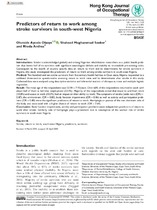Predictors of return to work among stroke survivors in south-west Nigeria
Date
2021Author
Soeker, Mogammad Shaheed
Olaoye, Olumide Ayoola
Rhoda, Anthea
Metadata
Show full item recordAbstract
Introduction: Stroke is acknowledged globally and among Nigerian rehabilitation researchers as a public health problem that leaves half of its survivors with significant neurological deficits and inability to re-establish pre-existing roles. Consequent to the dearth of country specific data on return to work and its determinants for stroke survivors in Nigeria, this study investigated the predictors of return to work among stroke survivors in south-west Nigeria. Method: Two hundred and ten stroke survivors from five tertiary health facilities in Osun state, Nigeria responded to a validated three-section questionnaire assessing return to work rates and its determinants after stroke in this study. Collected data were analysed using descriptive statistics and inferential statistic of chi-square, t-test and multiple logistic regression. Result: The mean age of the respondents was 52.90 ± 7.92 years. Over 60% of the respondents returned to work with about half of them in full time employment (32.9%). Majority of the respondents noted that travel to and from work (43.8%) and access at work (43.3%) had an impact on their ability to work. The symptoms of stroke (odds ratio (OR) = 0.87), the environment (OR = 0.83), body function impairments (OR = 0.86) as well as activity and participation problems (OR = 0.80) were the significant predictors of return to work. Hemiplegia or paresis of the non-dominant side of the body was associated with a higher chance of return to work (OR = 7.64). Conclusion: Body function impairments, activity and participation problems were independent predictors of return to work after stroke. Similarly, side of hemiplegia plays a prominent role in resumption of the worker role of stroke survivors in south-west Nigeria. © The Author(s) 2021.

